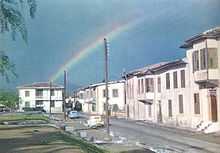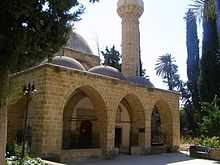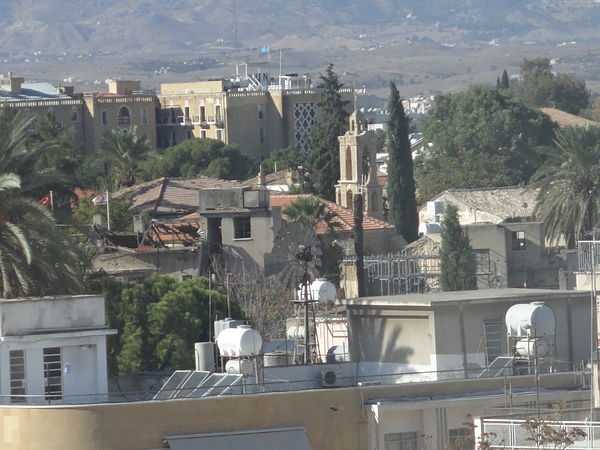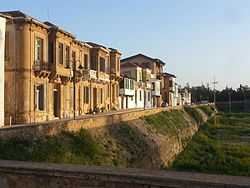Arab Ahmet, Nicosia
| Arab Ahmet | |
|---|---|
| Άραπ Άχμετ, Arab Ahmet | |
|
Zahra Street along the city walls | |
 Arab Ahmet Location in Cyprus | |
| Coordinates: 35°10′38″N 33°21′28″E / 35.17722°N 33.35778°ECoordinates: 35°10′38″N 33°21′28″E / 35.17722°N 33.35778°E | |
| Country |
|
| • District | Nicosia District |
| Country (controlled by) |
|
| • District | Lefkoşa District |
| Municipality | North Nicosia |
| Population (2011)[1][2] | |
| • Total | 3,550 |
| Time zone | EET (UTC+2) |
| • Summer (DST) | EEST (UTC+3) |
Arab Ahmet is a Neighbourhood, Quarter, Mahalla or Parish of Nicosia, Cyprus[1][3][4] and the mosque situated therein. Both the Quarter and the mosque are named after Arab Ahmet Pasha, one of the Turkish commanders in the Ottoman conquest of Nicosia.[5] It is spelled Arabahmet in Turkish and Άραπ Άχμετ in Greek.
At the last Census (2011) it had a population of 3,550.[1][2][6] It covers the historic Arab Ahmet neighbourhood in the west of Nicosia within the walls, plus an area west of that outside the walls up to the municipal boundary [7]
The population in 1946 was 2,617[8] (576 Greek, 846 Turkish, 1195 other - mostly Armenian, some Latin community). Together with the neighbouring Karamanzade Neighbourhood, it was part of the predominantly Armenian area of Nicosia.
The Neighbourhood outside the walls, is now delimited by the Dept. of Lands and Surveys [7] as follows: The boundary line passes from the point of the Quirini or Cephane (Jeb Khane) bastion to the roundabout just north of the bastion. Namely, the roundabout at the corner of the former site of the Turkish Cemetery,[9] now the site of the Turkish Embassy in Cyprus.[10] From there the boundary continues along Bedrettin Demirel Avenue (Hilarion Avenue) for about a mile to the old municipal boundary. The boundary is then coterminous with the municipal border in a south-westerly direction until the vicinity of the Central Prison. From here the boundary passes south of the prison due east, via Norman St., thence along Dereboyu Avenue and Markos Drakos Ave. until the point of the Roccas bastion. This area includes the Ledra Palace Hotel, British High Commission, Central Prison and the Turkish Cypriot Assembly of the Republic.[11] Parts of the neighborhood outside the walls in the north have been detached from the Arab Ahmet neighborhood and are now considered parts of Köşklüçiftlik.
History

Arab Ahmet was one of the original 12 Quarters as they existed shortly after the Ottoman conquest of Nicosia in 1570 and, like the others, was named after and put in charge of one of the commanders of the victorious army[5]
It is one of the later 24 historic Quarters or Neighbourhoods of Nicosia within the walls.[3] In 1923 it was extended to encompass an extensive area outside the walls,[12] linked by the road just to the north of the Mula (Zahra) bastion. According to the 1923 boundary extension beyond the walls, the northern boundary (with Ibrahim Pasha Quarter) was formed by a straight line from the salient of the Quirini/Cephane bastion, to the south-west comer of the Turkish cemetery. The southern boundary (with Tophane Quarter - renamed Ayios Andreas in Sept. 1945[3]) ran West from the "new" entrance, Paphos Gate, along the Bridge Road, across the Pediaios Potamos Bridge and along the Central Prison Road until it meets the Town boundary.[12] (Subsequent adjustment placed the southern boundary slightly north of this [7]).
The eponymous mosque was founded in the early 18th century.[13]
Arab Ahmet neighbourhood was the most prestigious residential area of Nicosia, where the Turkish high-ranking officials and the Kadis and the Pashas had their homes. First of all it was near the old Ottoman Saray (previously Lusignan palace) and easy for the high-ranking officials to go to their work on foot. Secondly it was the coolest place in the evening during the summer. Because it could get the best of the evening breeze, coming from the west, from the direction of the Morphou Bay into the Mesaoria plain.
Armenian Cypriots had been concentrated in the area since the Ottoman conquest. Many other Armenians, who escaped from the massacres in Anatolia, settled in the Arab Ahmet neighbourhood and lived there until the inter-communal troubles of 1963, when they fled the quarter. Since most of the Armenians from Anatolia could speak Turkish, they preferred to live alongside Turkish Cypriots, using the same language. The Armenians were known as tradesmen and they were famous especially in the fields of jewelry, tailory, photography and carpet-selling.[3]
Landmarks
Arab Ahmet mosque

Arab Ahmet Mosque is situated in the western Arab Ahmet Quarter of Nicosia, the capital of Cyprus. It was built in the late 16th century in classical Ottoman architecture.[13][14] It is famous both for its beautiful Turkish architectural style and for the graves of historically important people in its courtyard. It was built in the early 18th century in memory of Arab Ahmet Pasha, one of the Turkish commanders during the conquest of Cyprus. In 1845, it was renovated due to the great amount of renovations it needed. It is the only mosque in Cyprus to exhibit typical Turkish domes. It is rectangular and a large central dome covers its main body. Three smaller domes cover the entrance, and four more cover corners of the mosque.[13]
Arab Ahmet aqueduct
This aqueduct, known as Arab Ahmet Su,[15] was one of the two main sources of water supply in 19th century Nicosia. It is named after Ahmed Pasha (not the neighbourhood), who seems to have rebuilt or repaired it as the principal water-conduit which supplied the town from the upper reaches of the river Pediaios.[5] From there the aqueduct approached the city from the south-west bringing water into the city via Paphos Gate, near Arab Ahmet neighbourhood [16]
Ledra Palace Hotel

The Ledra Palace Hotel was until 1974 one of the largest and most glamorous hotels of Nicosia.[17] The hotel was designed by the German Jewish architect Benjamin Günsberg and was built between 1947-1949 on what was then called King Edward VII Street in the Quarter (Enoria) of Arab Ahmet.[18] This part of the road is now named Markos Drakos Avenue (since 1960) and another part is named Selim II Avenue. Following the Turkish invasion of Cyprus it fell within the boundaries of the UN Buffer Zone and now serves as the headquarters for Sector 2 United Nations Roulement Regiment (URR) part of UNFICYP.[19] The Ledra Palace Hotel has played host to many high level meetings between Greek Cypriot and Turkish Cypriot leaders,[20] as well as hundreds of structured conflict resolution workshops between Greek Cypriot and Turkish Cypriot peace builders.[21][22][23]
Central Prison of Nicosia
The Central Prison of Nicosia is the only correctional facility in Cyprus.[24] It is located in the west of the neighbourhood, south of the Green Line[7] and was built by the British in 1894. It was used, until 1955, both as place of temporary detention of persons under judicial decree as well as a place of detention of those condemned by the courts to imprisonment.
Current division
The southern fringe of the neighbourhood outside the walls, around the Ledra Palace Hotel, is under the control of the Cyprus government or the United Nations.[7] The Arab Ahmet Neighbourhood of Nicosia Turkish Municipality only covers that part within the walls, while the area beyond the walls is organised as a the separate Neighbourhood of Köşklüçiftlik (old name Keushk Chiftlik)[25] This position is summarised below.
| Area | Population 2011 |
|---|---|
| Arab Ahmet within walls | 561 |
| Köşklüçiftlik | 2,939 |
| Arab Ahmet (Cyprus gov. sector) | 50 |
| TOTAL | 3,550 |
References
- ↑ 1.0 1.1 1.2 Census of Cyprus 2011
- ↑ 2.0 2.1 Census organised by the Turkish Cypriots in the occupied area http://www.devplan.org/Nufus-2011/nufus%20ikinci_.pdf retrieved October 2013
- ↑ 3.0 3.1 3.2 3.3 Coexistence in the Disappeared Mixed Neighbourhoods of Nicosia by Ahmet An (Paper read at the conference: Nicosia: The Last Divided Capital in Europe, organized by the London Metropolitan University on 20 June 2011)
- ↑ 6th edition of the publication "Statistical Codes of Municipalities, Communities and Quarters of Cyprus" (publ. Statistical Service of Republic of Cyprus)
- ↑ 5.0 5.1 5.2 "A description of the historic monuments of Cyprus. Studies in the archaeology and architecture of the island" by George Jeffery, Nicosia 1918
- ↑ Total - see details in this article
- ↑ 7.0 7.1 7.2 7.3 7.4 "Quarters of Nicosia" Prepared and published by the Dept. of Lands and Surveys, Cyprus, 1985, Revised 1997. Series DLS30. Scale 1:7500
- ↑ Census of Cyprus, 1946
- ↑ "Romantic Cyprus" by Kevork Keshishian, pub 1958, Nicosia. Attached map of Nicosia
- ↑ Google Maps, retrieved Dec 2013
- ↑ British American Tobacco archives retrieved from http://tobaccodocuments.org/guildford_misc/500010628-0648.html Dec 2013
- ↑ 12.0 12.1 Order No. 397 published in Cyprus Gazette No. 1597, 4 August 1923
- ↑ 13.0 13.1 13.2 Ahmet Gazioglu, The Turks in Cyprus - A Province of the Ottoman Empire, London, 1990
- ↑ The Arabahmet Mosque, Nicosia, North Cyprus
- ↑ Levkosia: The Capital Of Cyprus, by Louis Salvator (publ.1881)
- ↑ Map of Nicosia, from survey by Capt. H. Kitchener, pub 1885, copies available from Dep. of Lands & Surveys, Nicosia
- ↑ "A Letter From The Publisher". Time Magazine. 29 July 1974. Retrieved 2008-03-07.
- ↑ As recorded in Land Registry
- ↑ "British Rescue Convoy Evacuates Foreigners; 380 Rescued From Hotel". New York Times. 22 July 1974. Retrieved 2008-03-07.
- ↑ "Cyprus' religious leaders hold historic meeting". International Herald Tribune (The Associated Press). 21 February 2007. Retrieved 2008-03-07.
- ↑ Building Bridges across the Green Line
- ↑ The Broken Olive Branch: Nationalism, Ethnic Conflict, and the Quest for Peace in Cyprus
- ↑ Masks of Demons: A journey into the Discovering and Breaking of Stereotypes in a Society in Conflict
- ↑ "Defence - Security - Prisons Department". Cyprus Government Web Portal. cyprus.gov.cy. Retrieved 2009-04-27.
- ↑ Mahallas,Nicosia Turkish Municipality http://www.lefkosabelediyesi.org/tr/index.php/lefkosa/resmi-kurumlar/muhtarl-klar retrieved Oct 2013
| ||||||||||
